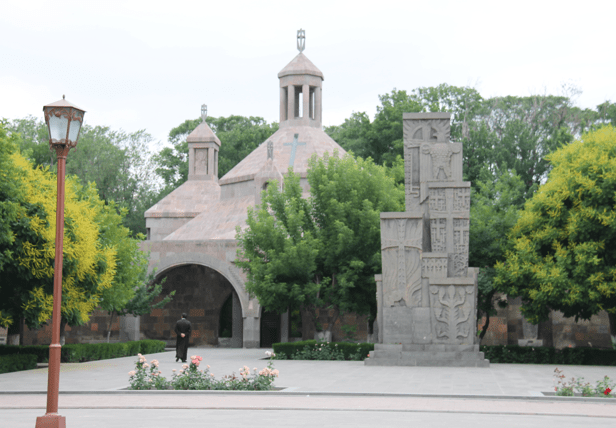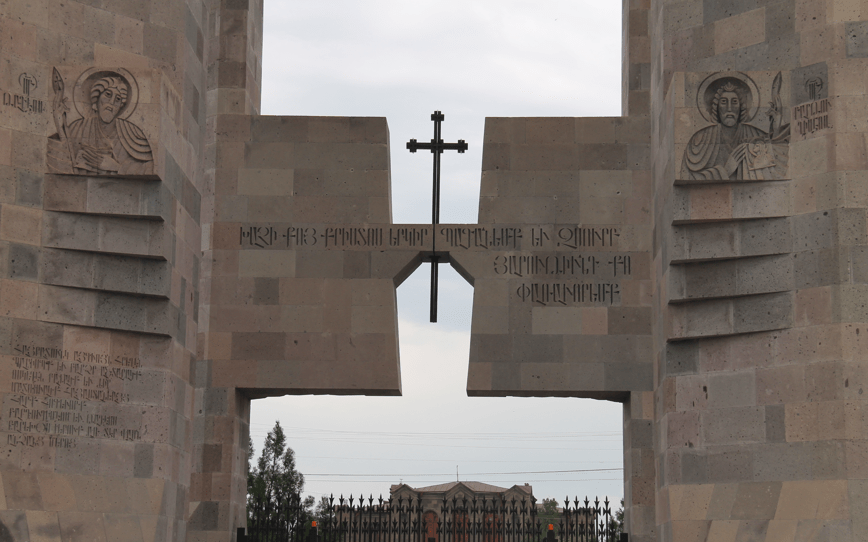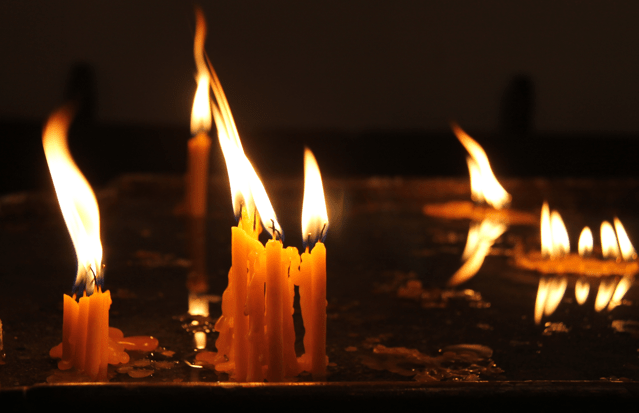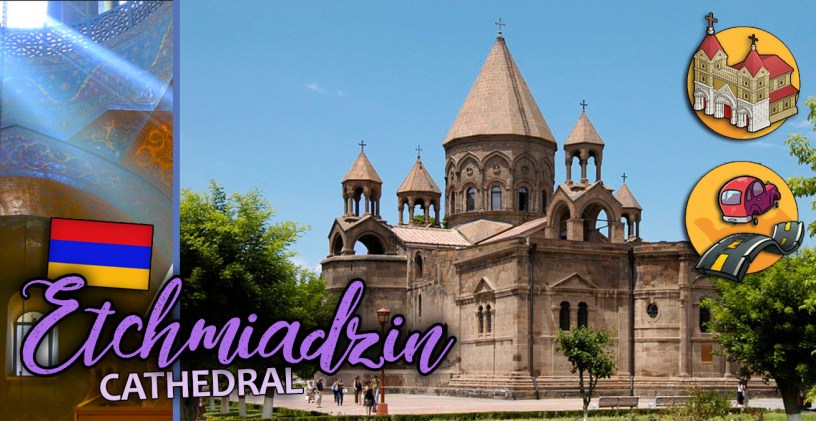Armavir Province
Vagharshapat
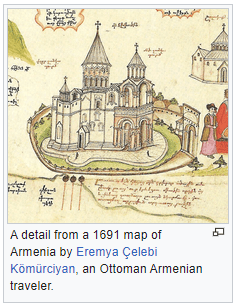
The grand entrance to the complex is beautiful, I love the design and the entrance is one of my favourite areas of this ancient complex, there are many different segments and buildings around here


History…
Etchmiadzin Cathedral (Armenian: Էջմիածնի մայր տաճար) is the mother church of the Armenian Apostolic Church – according to most scolars, this is was the first Cathedrak built in ancient Armenia and often considered the oldest cathedral in the world!
Original church built in 4th c. between 301 and 303 by saint Gregory the Illuminator once Armenia adopted Christianity as its national religion. The Cathedral suffered neglect and lost its significance for a while but then in 1441 it was restored and has been since then the administratove headquarters of the Armenian Church

As the main shrine of Armenian Christians worldwide, Etchmiadzin has been an important location in Armenia not only religiously, but also politically and culturally.
According to Armenian church tradition, the cathedral was built between 301 and 303, near the royal palace in what was then the Armenian royal capital of Vagharshapat, on the location of a pagan temple. In the early fourth century the Kingdom of Armenia, under Tiridates III, had become the first country in the world to adopt Christianity as a state religion. Agathangelos narrates in his History of the Armenians the legend of the foundation of the cathedral. Armenia’s patron saint Gregory the Illuminator had a vision of Jesus Christ descending from heaven and striking the earth with a golden hammer to show where the cathedral should be built. Hence, the patriarch gave the church the name of Etchmiadzin + ծին tsin “begotten”), which translates to “the Descent of the Only-Begotten [Son of God].” However, the name Etchmiadzin did not come into use until the 15th century,[4] while earlier sources call it “Cathedral of Vagharshapat.”[J] The Feast of the Cathedral of Holy Etchmiadzin (Տոն Կաթողիկե Սբ. Էջմիածնի) is celebrated by the Armenian Church 64 days after Easter, during which “a special hymn is sung, written by the 8th century Catholicos Sahak III of Dzorapor, telling of St. Gregory’s vision and the Cathedral’s construction.
During archaeological excavations at the cathedral in 1955–56 and 1959, led by architectural historian Alexander Sahinian, remains of the original fourth-century building were discovered—including two levels of pillar bases below the current ones and a narrower altar apse under the present one. Based on these findings, Sahinian asserted that the original church had been a three-naved vaulted basilica, similar to the basilicas of Tekor, Ashtarak and Aparan (Kasakh). However, other scholars, have rejected Sahinian’s view. Among them, Suren Yeremian and Armen Khatchatrian held that the original church had been in the form of a rectangle with a dome supported by four pillars. Stepan Mnatsakanian suggested that the original building had been a “canopy erected on a cross [plan],” while architecture researcher Vahagn Grigoryan suggests what Mnatsakanian describes as an “extreme view,” according to which the cathedral has been essentially in the same form as it is today.
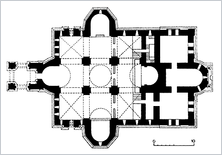
Reconstruction and decline
ccording to Faustus of Byzantium, the cathedral and the city of Vagharshapat were almost completely destroyed during the invasion of Persian King Shapur II in the 360s (circa 363).[Due to Armenia’s unfavorable economic conditions, the cathedral was renovated only partially by Catholicoi Nerses the Great (r. 353–373) and Sahak Parthev (r. 387–439).
In 387, Armenia was partitioned between the Roman Empire and the Sasanian Empire. The eastern part of Armenia where Etchmiadzin was located remained under the rule of Armenian vassal kings subject to Persia until 428, when the Armenian Kingdom was dissolved.

In 450, in an attempt to impose Zoroastrianism on Armenians, Sasanian King Yazdegerd II built a fire temple inside the cathedral.[5] The pyre of the fire temple was unearthed under the altar of the east apse during the excavations in the 1950s.
By the last quarter of the fifth century the cathedral was dilapidated. According to Ghazar Parpetsi, it was rebuilt from the foundations by marzban (governor) of Persian Armenia Vahan Mamikonian in 483/4,when the country was relatively stable, following the struggle for religious freedom against Persia. Most. researchers have concluded that, thus, the church was converted into cruciform church and mostly took its current form. The new church was very different from the original one and “consisted of quadric-apsidal hall built of dull, grey stone containing four free-standing cross-shaped pillars disdained to support a stone cupola.” The new cathedral was “in the form of a square enclosing a Greek cross and contains two chapels, one on either side of the east apse.” According to Robert H. Hewsen, the design of the new church was a mixture of the design of a Zoroastrian fire temple and a mausoleum of classical antiquity.
Although the seat of the Catholicos was transferred to Dvin sometime in the 460s–470s or 484, the cathedral never lost its significance and remained “one of the greatest shrines of the Armenian Church.”[65] The last known renovations until the 15th century were made by Catholicos Komitas in 618 (according to Sebeos) and Catholicos Nerses III (r. 640–661). In 982 the cross of the cathedral was reportedly removed by an Arab emir.
During these centuries of neglect, the cathedral’s “condition deteriorated so badly” that it prompted the prominent archbishop Stepanos Orbelian to write one of his most notable poems, “Lament on Behalf of the Cathedral” (“Ողբ ի դիմաց Կաթողիկէին” Voğb i dimats Katoğikein) in 1300.[M] In the poem, which tells about the consequences of the Mongol and Mamluk invasions of Armenia and Cilicia, Orbelian portrays Etchmiadzin Cathedral “as a woman in mourning, contemplating her former splendor and exhorting her children to return to their homeland […] and restore its glory.”
Following the fall of the Armenian Kingdom of Cilicia in 1375, the See of Sis experienced decline and disarray. The Catholicosate of Aghtamar and the locally influential Syunik bishops enhanced the importance of the region around Etchmiadzin. In 1441 a general council of several hundred religious figures met in Etchmiadzin and voted to reestablish a catholicosate there. The cathedral was restored by Catholicos Kirakos (Cyriacus) between 1441 and 1443. At that time Etchmiadzin was under the control of the Turkic Kara Koyunlu, but in 1502, Safavid Iran gained control of parts of Armenia, including Etchmiadzin, and granted the Armenian Church some privileges.
During the 16th and 17th centuries, Armenia suffered from its location between Persia and Ottoman Turkey, and the conflicts between those two empires. Concurrently with the deportation of up to 350,000 Armenians into Persia by Shah Abbas I as part of the scorched earth policy during the war with the Ottoman Empire,] Etchmiadzin was plundered in 1604. The Shah wanted to “dispel Armenian hopes of returning to their homeland” by moving the religious center of the Armenians to Iran. in order to provide Persia with a strong Armenian presence. He wanted to destroy the cathedral and have its remains brought to Isfahan. In the event, only some important stones—the altar, the stone where Jesus Christ descended according to tradition, and Armenian Church’s holiest relic, the Right Arm of Gregory the Illuminator—were moved to New Julfa, Isfahan in central Iran. They were incorporated in the local Armenian St. Georg Church when it was built in 1611.

